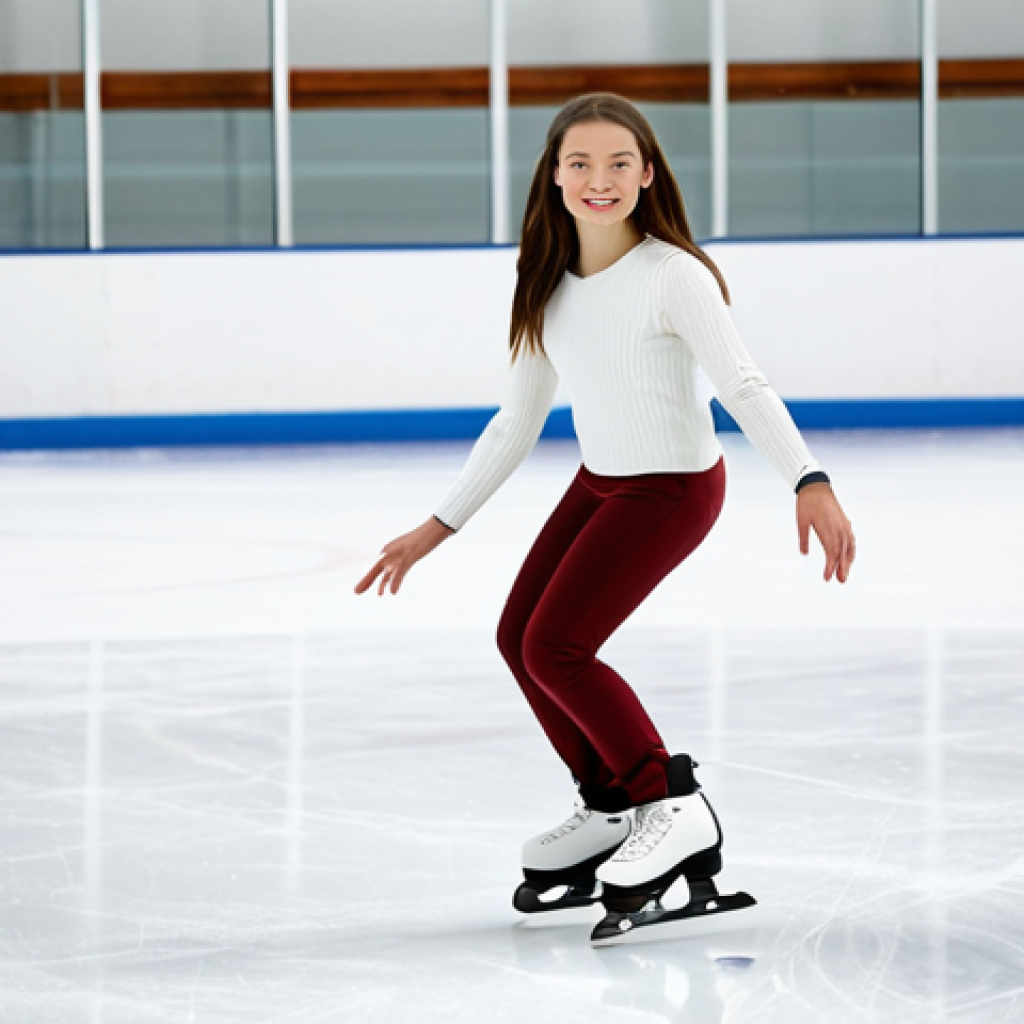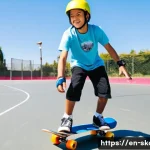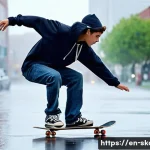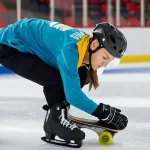The crisp winter air, the exhilarating rush of wind against your face, the echoing laughter of friends – these are the things I immediately associate with ice skating.
Growing up in a small town with a frozen pond every winter, skating wasn’t just a hobby; it was a way of life. It was about the clumsy first glides, the inevitable tumbles, and the triumphant moments of finally feeling steady on the ice.
My friends and I, armed with mismatched skates and boundless enthusiasm, would spend hours perfecting our spins (or at least attempting them) and chasing each other across the frozen surface.
Now, reflecting on those memories, I realize that those seemingly simple skating sessions were filled with so much joy, camaraderie, and valuable life lessons.
From these lessons, I am now writing about ice skating. Let’s delve into the details in the following article.
## Finding the Right Skates: A Journey of Comfort and PerformanceChoosing the right ice skates can feel like embarking on a quest. It’s not just about picking a pair that looks good; it’s about finding skates that fit well, support your ankles, and match your skill level.
I remember the first pair of skates I ever owned – hand-me-downs from a cousin. They were several sizes too big, and I spent more time wobbling than gliding.
From that early experience, I learned the importance of a proper fit. If you are beginner, start with rental skates at your local rink, but I highly recommend investing in your own pair when you start skating regularly.
Understanding Different Types of Skates

There are various types of skates, each designed for specific purposes. Figure skates have a toe pick for jumps and spins, while hockey skates offer more ankle support and maneuverability for quick turns and stops.
Recreational skates are a good option for beginners, providing a balance of comfort and performance. I personally prefer recreational skates for their versatility, as I enjoy both casual skating and trying out some basic figure skating moves.
The Importance of a Proper Fit
A properly fitted skate should feel snug but not too tight. Your toes should be able to wiggle slightly, and your heel should not lift when you flex your ankle.
Ill-fitting skates can lead to blisters, foot pain, and even injuries. Consider getting professionally fitted at a local skate shop. Experts can assess your foot type, recommend suitable skate models, and ensure a perfect fit.
I made the mistake of ordering skates online without trying them on first, and ended up with a pair that pinched my toes. It was a costly lesson in the importance of trying before buying.
Lacing Up for Success
Lacing your skates correctly is just as important as the fit. Start by tightening the laces around your ankle to provide support, and then loosen them slightly around your toes to allow for flexibility.
The goal is to achieve a balance of support and comfort. I always double-check my laces before stepping onto the ice, as loose laces can compromise my balance and control.
Mastering the Basics: From Wobbly Steps to Confident Glides
Learning to ice skate is a journey of patience, persistence, and plenty of laughter. It’s about embracing the initial wobbles, celebrating the small victories, and enjoying the process of improvement.
I still remember the first time I managed to skate across the rink without falling – it felt like a monumental achievement!
Finding Your Balance
Balance is key to ice skating. Start by practicing on the sidelines, getting a feel for the ice and shifting your weight from one foot to the other. Bend your knees slightly and keep your core engaged to maintain stability.
It’s also helpful to focus on a point in the distance to avoid looking down, which can throw off your balance.
The Art of Falling (and Getting Back Up)
Falling is an inevitable part of learning to skate. The key is to fall correctly to minimize the risk of injury. Try to fall to the side, tucking your arms in and protecting your head.
Getting back up can be tricky, but with a little practice, it becomes easier. Start by getting on your hands and knees, then place one foot flat on the ice and push yourself up using your hands.
Taking Your First Glides
Once you feel comfortable with your balance, start taking small glides. Push off with one foot, gliding on the other, and then switch. Focus on maintaining a smooth, controlled motion, and avoid jerky movements.
As you become more confident, you can gradually increase the length and speed of your glides. Remember, practice makes perfect!
Exploring Fun Skating Activities: Beyond the Basic Lap
Ice skating is not just about skating in circles; it’s about exploring different activities and finding ways to make it fun. From playing games with friends to trying out some basic figure skating moves, there are endless possibilities to keep things interesting.
Ice Skating Games with Friends
One of my favorite ways to make skating more enjoyable is to play games with friends. Tag, red light green light, and follow the leader are all great options.
These games not only add an element of fun but also help improve your skating skills and coordination.
Trying Out Basic Figure Skating Moves
While I’m not a professional figure skater, I enjoy trying out some basic moves like forward crossovers, backward skating, and simple spins. These moves require practice and coordination, but they can be incredibly rewarding to master.
There are plenty of online tutorials and instructional videos that can guide you through the steps.
Ice Dancing: A Blend of Skating and Rhythm
Ice dancing combines the athleticism of skating with the artistry of dance. While it requires a high level of skill and training, it can be a beautiful and expressive way to enjoy skating.
Even if you’re not ready to compete, you can try out some basic ice dancing steps with a partner. The music adds another dimension to the experience, making it even more enjoyable.
Maintaining Your Skates: Ensuring Longevity and Performance
Taking care of your ice skates is essential for ensuring their longevity and optimal performance. Regular maintenance can prevent rust, keep the blades sharp, and extend the life of your skates.
Drying Your Skates After Each Use
After each skating session, it’s important to dry your skates thoroughly to prevent rust. Wipe down the blades with a soft cloth, and then remove the insoles to allow them to air dry.
Avoid storing your skates in a damp bag, as this can promote rust and mildew growth.
Sharpening Your Blades Regularly
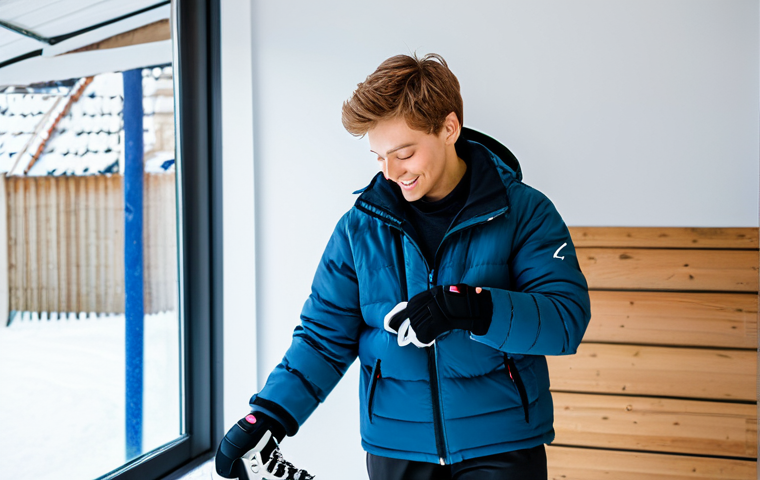
Sharp blades are crucial for maintaining control and edge while skating. Dull blades can make it difficult to turn and stop, increasing the risk of falls.
How often you need to sharpen your blades depends on how often you skate and the quality of the ice. As a general rule, you should sharpen your blades every 20-30 hours of skating.
Storing Your Skates Properly
When storing your skates, use blade guards to protect the blades from damage. Store your skates in a cool, dry place, away from direct sunlight and heat.
Avoid stacking heavy objects on top of your skates, as this can damage the boots.
Safety First: Protecting Yourself on the Ice
While ice skating is a fun and rewarding activity, it’s important to prioritize safety to minimize the risk of injuries. Wearing appropriate safety gear, being aware of your surroundings, and following rink rules can help you stay safe on the ice.
Wearing Appropriate Safety Gear
Helmets are essential for protecting your head in case of a fall. Wrist guards can help prevent wrist fractures, and knee and elbow pads can provide additional protection.
I always wear a helmet when skating, especially when trying out new moves or skating on crowded rinks.
Being Aware of Your Surroundings
Pay attention to other skaters and avoid skating too close to them. Be aware of your surroundings and avoid distractions, such as talking on your phone or listening to music too loudly.
Look out for obstacles on the ice, such as cracks, holes, or debris.
Following Rink Rules and Guidelines
Familiarize yourself with the rules and guidelines of the ice rink. Obey all posted signs and instructions from rink staff. Avoid skating in areas that are designated for lessons or maintenance.
The Social Side of Skating: Making Friends and Building Community
Ice skating can be a great way to meet new people, make friends, and build community. Whether you’re skating with friends, taking lessons, or joining a skating club, there are plenty of opportunities to connect with other skaters.
Skating with Friends and Family
Skating with friends and family is a fun and social activity that can create lasting memories. Share tips and encouragement, and celebrate each other’s achievements.
I love organizing skating outings with my friends and family, as it’s a great way to bond and stay active.
Taking Lessons and Joining Skating Clubs
Taking lessons from a qualified instructor can help you improve your skating skills and learn new techniques. Joining a skating club can provide you with opportunities to skate with other enthusiasts, participate in events, and receive coaching.
Participating in Local Skating Events
Many communities host local skating events, such as ice shows, competitions, and holiday-themed skating parties. Participating in these events can be a great way to showcase your skills, meet new people, and support your local skating community.
Here is a table summarizing key aspects of ice skating:
| Aspect | Description | Tips |
|---|---|---|
| Skate Selection | Choosing the right skates for your skill level and foot type. | Get professionally fitted; consider recreational skates for beginners. |
| Basic Techniques | Mastering balance, gliding, and stopping. | Practice on the sidelines, bend your knees, and maintain focus. |
| Fun Activities | Exploring games, figure skating moves, and ice dancing. | Play tag, try crossovers, and enjoy the music. |
| Maintenance | Keeping skates in good condition. | Dry after use, sharpen blades, and store properly. |
| Safety | Protecting yourself on the ice. | Wear a helmet, be aware of surroundings, and follow rink rules. |
| Social | Building community through skating. | Skate with friends, take lessons, and join clubs. |
Choosing the right ice skates and mastering the basics is just the beginning. Whether you’re twirling in the rink or gliding along a frozen pond, the joy and community found in ice skating make every wobble and glide worthwhile.
So lace up your skates, invite your friends, and discover the exhilaration that awaits on the ice! I feel you will have an unforgettable experience!
In Closing
As you embark on your ice skating adventure, remember that it’s not just about the destination, but the journey. Embrace the wobbles, celebrate the small victories, and most importantly, have fun! The ice is waiting, and so are countless moments of joy and exhilaration. So go ahead, lace up those skates, and glide into a world of endless possibilities!
From selecting the perfect skates to mastering your first glides and sharing laughter with friends, ice skating offers something for everyone. It’s a journey of self-discovery, skill-building, and community connection. And it is perfect for the winter!
Good to Know Tips
1. Skate Sizing Tip: Always try on skates with the socks you plan to wear while skating. This will ensure a comfortable and accurate fit.
2. Blade Care Essential: After drying your blades, consider using a rust inhibitor spray to provide an extra layer of protection against corrosion, especially in humid environments.
3. Finding Local Rinks: Use online directories like Yelp or Google Maps to find ice skating rinks near you. Check their schedules for public skating sessions.
4. Warming Up is Key: Before stepping onto the ice, do some simple stretches to warm up your muscles and prevent injuries. Focus on your ankles, knees, and wrists.
5. Community Events: Check your local community center or skating rink for upcoming events, such as ice shows, holiday-themed skating parties, and beginner workshops.
Key Takeaways
Choosing the right skates is vital for comfort and performance. Properly fitted skates prevent blisters and injuries, enhancing your overall experience.
Mastering basic techniques like balance and gliding is essential for building confidence on the ice. Start slow, practice regularly, and celebrate small victories.
Ice skating is more than just a sport; it’s a social activity that brings people together. Share the joy of skating with friends and family to create lasting memories.
Prioritize safety by wearing appropriate gear like helmets and wrist guards. Be aware of your surroundings and follow rink rules to minimize the risk of injuries.
Regular maintenance, including drying and sharpening blades, ensures the longevity and optimal performance of your skates. Invest in quality maintenance tools and follow best practices.
Frequently Asked Questions (FAQ) 📖
Q: I’m a complete beginner. What kind of skates should I buy, and how do I know if they fit properly?
A: Okay, so as a newbie, don’t splurge on expensive skates right off the bat! Rental skates are totally fine to start with. But if you’re ready to commit, figure skates (with the toe picks) are generally easier for beginners since they offer more ankle support and are easier to balance on.
Hockey skates are cool too, but they’re designed for speed and agility, which can be trickier when you’re just starting out. As for fit, the skates should feel snug but not tight.
Your toes should just barely touch the end when you’re standing, but they shouldn’t be crammed in there. When you lace them up, your heel shouldn’t lift up much.
If your heel’s swimming around in the skate, they’re too big! Honestly, the best thing to do is go to a skate shop and have them help you find the right fit.
They’ll know what to look for.
Q: I’m terrified of falling!
A: ny tips for staying upright (or at least falling gracefully) while ice skating? A2: Oh honey, falling is part of the deal! Everyone falls, especially when they’re learning.
The trick is to try and relax (easier said than done, I know!) and avoid tensing up, which can make injuries worse. When you feel yourself going down, try to bend your knees and lean forward.
This helps you fall onto your padded areas (your bum and your knees) instead of face-planting. Also, practice falling and getting back up a few times when you first get on the ice.
That way, you’ll feel a little more confident. And for goodness sake, wear a helmet! Even if you think it looks dorky, it can save you a lot of headaches (literally).
Seriously, I saw this one guy at the rink who didn’t wear a helmet, and he slipped and smacked his head. Looked like it hurt real bad!
Q: Are there any essential things I should bring with me to the ice rink, besides skates?
A: Absolutely! First and foremost, wear warm, comfortable clothing in layers. You’ll warm up as you skate, so you want to be able to peel off layers if you get too hot.
Thin, moisture-wicking socks are also key – avoid thick, bulky socks, as they can make your skates feel tight and uncomfortable. Gloves or mittens are a must to protect your hands from the cold and from scraping the ice if you fall.
A helmet, of course, and knee pads are also a good idea, especially if you’re just starting out. Oh, and don’t forget a water bottle to stay hydrated!
Skating is surprisingly hard work. Finally, bring a small towel to wipe down your skates after you’re done. That’ll help keep them in good condition.
You might also want to bring some pain relievers if you’re prone to sore muscles. Trust me, you’ll thank me later! I always bring an ibuprofen just in case!
📚 References
Wikipedia Encyclopedia
